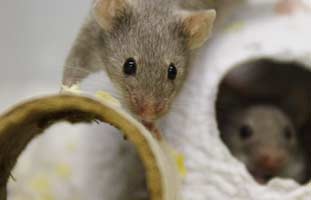Mortality, including animals ‘found dead’, is one of the three main causes of severe suffering. A recent paper by Jessica Cait and others at the University of Guelph, Canada, has highlighted a cause of morbidity and mortality in rodents that many people may not be aware of – conventional laboratory housing. Conventional housing was defined as small cages with just food, water and litter, as opposed to ‘enriched housing’ which included one or more of the following: nesting material, nest boxes, running wheels, and/or opportunities to perform other natural behaviours, like foraging or exploring.
The systematic review of 214 studies, using 6,495 animals, found that conventional housing significantly exacerbated disease severity in studies of anxiety, cancer, cardiovascular disease, depression and stroke. It also increased the risk of death at any point in time by 48%, due to the chronic stress of being housed in a suboptimal environment.
‘Enriched housing’ actually increased median survival by 9.3%. The authors point out that this exceeds the effects of leading life-extending compounds resveratrol (which increases median survival by 4.1%) and metformin (which increases mean lifespans by 5.8%). They also suggest that typical research rodents should be termed ‘CRAMPED’ (cold, rotund, abnormal, male-biased, poorly surviving, enclosed and distressed).
The implications of the review, for both animal welfare and translatability, are all too clear. The paper would make a helpful discussion starter around reviewing housing, husbandry and care for any species, to reduce morbidity and mortality and improve welfare – even if standards are already better than ‘conventional’ cages (or pens, or tanks). This website also includes guidance on reviewing and refining animals’ lifetime experiences, and avoiding mortality.
Reference: Conventional laboratory housing increases morbidity and mortality in research rodents: results of a meta-analysis Cait et al. (2022) BMC Biology, doi.org/10.1186/s12915-021-01184-0
